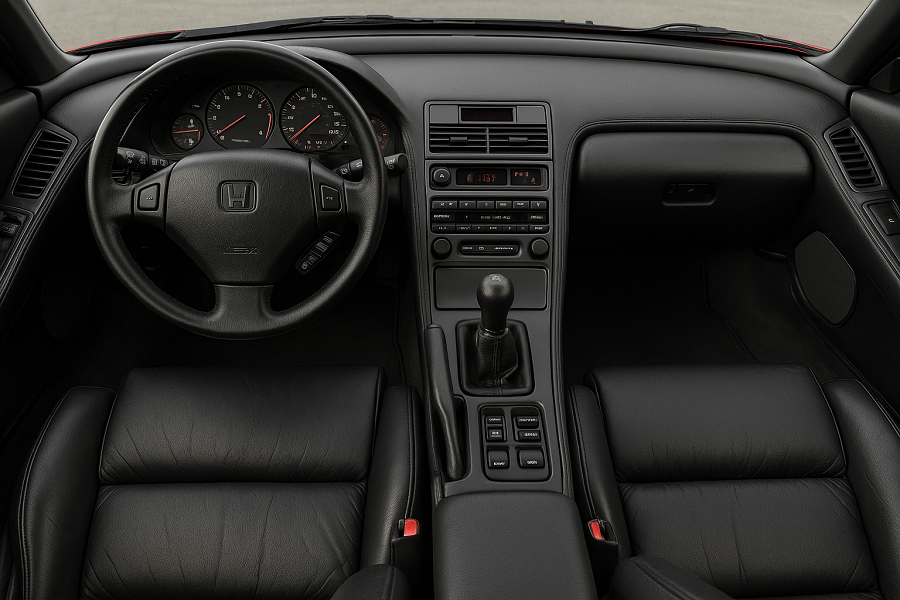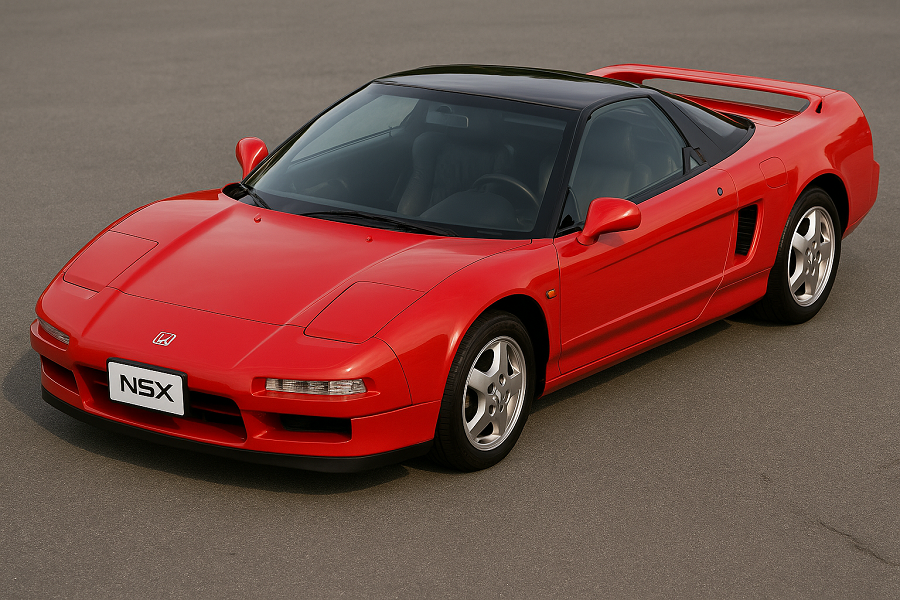Introduction: A Supercar with a Soul
In 1990, the Honda NSX redefined what a supercar could be. It wasn’t just about raw speed or flashy looks—it brought together cutting-edge engineering, reliability, and daily usability in a package that stunned the automotive world. Nicknamed the “everyday supercar,” the Honda NSX 1990 featured a lightweight all-aluminium body, a VTEC-powered mid-engine layout, and the kind of handling finesse usually reserved for race cars. Backed by Honda’s F1 experience and tuned with input from Ayrton Senna himself, the NSX didn’t just challenge Ferrari—it changed how we saw Japanese performance forever.
The Vision Behind the NSX
Honda created the NSX to rival the best European supercars—especially Ferrari. Inspired by the Pininfarina HP-X concept, the project aimed to blend high performance with real-world reliability. The name “NSX” stood for “New Sports eXperimental,” highlighting its bold, forward-thinking design. Unlike traditional supercars of the time, the NSX focused on balance, efficiency, and precision. Honda’s goal was simple yet ambitious: build a driver’s car that was fast, fun, and dependable enough for everyday use.
Ayrton Senna’s Touch: Engineering with a Champion
One of the most fascinating aspects of the NSX is that Ayrton Senna, Honda’s F1 legend, helped fine-tune it.
- Senna provided feedback on chassis stiffness and suspension tuning.
- He tested prototypes on Japanese and European circuits.
- His input led to a 50% increase in chassis rigidity.
This collaboration gave the NSX world-class handling and elevated its status from an excellent car to an iconic driver’s machine.
Engineering Marvel: Lightweight Innovation
The NSX was the world’s first production car with an all-aluminium monocoque body. This decision was groundbreaking at the time and saved nearly 200 kg compared to traditional steel bodies.
Engineering Highlights
| Feature | Details |
|---|---|
| Body Material | All-aluminium monocoque |
| Drag Coefficient | 0.32 |
| Weight Distribution | ~42/58 front/rear |
| Suspension | Four-wheel double wishbone |
| Inspiration | F-16 Fighter Jet (cockpit design) |

This engineering gave the NSX lightweight agility, superb rigidity, and unmatched visibility thanks to the F-16-style canopy.
The Beating Heart: C30A V6 with VTEC
At the heart of the 1990 NSX was the C30A engine, a naturally aspirated 3.0-liter V6 equipped with VTEC. It delivered:
- 270 horsepower (manual)
- 252 horsepower (automatic)
- 0–60 mph in ~5.7 seconds
- A redline of 8,000 RPM
This honda nsx 1990 engine was mid-mounted for perfect balance and had a titanium connecting rod setup—something typically found only in race engines at the time.
Driving Experience: Precision on the Road
Despite its performance, the Honda NSX 2005 was praised for being easy and enjoyable to drive daily.
Key Driving Traits:
- Smooth and quick 5-speed manual transmission
- Light clutch and responsive steering
- Precise throttle response thanks to drive-by-wire tech (ahead of its time)
- Mid-engine layout gave it superior balance
Whether carving through mountain roads or cruising through city streets, the NSX made performance feel approachable.
Comparing NSX to 90s Rivals
In the early 1990s, the NSX went head-to-head with some of the biggest names in the industry. Here’s how it stacked up:
NSX vs. Rivals
| Car | Engine | 0–60 mph | Body Material | Reliability |
|---|---|---|---|---|
| Honda NSX | 3.0L V6 VTEC | 5.7s | Aluminium | Excellent |
| Ferrari 348 | 3.4L V8 | 5.6s | Steel | Questionable |
| Porsche 911 | 3.6L Flat-6 | 5.3s | Steel | Good |
| Toyota Supra | 3.0L Twin Turbo | 5.0s | Steel | Very Good |
The NSX didn’t just keep up—it introduced a new benchmark for quality and usability in a supercar.
Rare in the Wild: NSX in Global & Pakistani Markets
With only about 18,000 units produced globally during its first generation, the 1990 NSX is a rare sight. Even rarer in markets like Pakistan, where:
- Only a handful were imported.
- NSX sightings are enthusiast-driven.
- RHD and LHD availability varied by country.
In Japan, the car was sold under Honda, while in North America, it wore the Acura NSX badge.
The Restoration Program & Maintenance Today
In 2024, Honda announced a restoration and parts support program for the NSX. This includes:
- Factory-authorized Genuine Compatible Parts
- Support for both mechanical and body restoration
- Aimed at preserving first-generation NSX models
Common Maintenance Insights:
- Timing belt replacement (~90,000 km)
- VTEC solenoid checks
- Suspension bushing wear
- Interior climate controls can age
Despite being over 30 years old, the NSX is remarkably reliable—with regular maintenance, many still perform like new.
Is the 1990 NSX a Good Investment?
Absolutely. Prices have steadily increased in recent years. Once overlooked, the NSX is now considered a classic.
Resale Trends
| Condition | honda nsx 1990 price Range (USD) |
|---|---|
| Fair (High miles) | $50,000 – $65,000 |
| Good (Low miles) | $70,000 – $90,000 |
| Collector quality | $100,000+ |
Its rarity, performance, and Honda’s new support program all contribute to its growing collector appeal.
11. What Owners Love (and Hate)
Loved Features:
- Reliable even after decades
- Mid-engine handling
- Naturally aspirated engine sound
- Easy-to-maintain compared to Euro supercars
Common Gripes:
- Limited trunk space
- No traction control (1990 version)
- Dated infotainment by today’s standards
- Automatic version lacks excitement

Missed Features in Competitor Content
Most existing reviews skip these essential angles:
- Interior Comfort: The NSX featured leather seats, power windows, and climate control—rare for 1990s sports cars.
- Fuel Economy: It achieved around 17–24 mpg, which was excellent for a mid-engine V6.
- Trim Breakdown:
- Base model: Standard equipment
- NSX-R (JDM only): Lightweight, track-focused
- Targa models: Added later in the decade
Final Verdict: Why the NSX Still Matters
The 1990 Honda NSX isn’t just a piece of automotive history—it’s a blueprint. It combined performance, design, innovation, and reliability in ways few others could. It proved that Japan could produce a world-class supercar—and do it better in some ways. The honda nsx 1990 for sale wasn’t just revolutionary in its time; it continues to inspire modern performance cars even today.
FAQ Section (SEO Optimized)
Q: What engine does the 1990 Honda NSX have?
A: A 3.0L DOHC V6 (C30A) with VTEC, producing 270 hp (manual).
Q: How fast is the 1990 Honda NSX?
A: 0–60 mph in around 5.7 seconds, with a top speed near 168 mph.
Q: Is the NSX considered a JDM car?
A: Yes, especially models sold in Japan. In North America, it was sold as the Acura NSX.
Q: What’s special about the 1990 NSX?
A: First mass-production car with an aluminium monocoque, tuned by Ayrton Senna, reliable, and daily-drivable.


